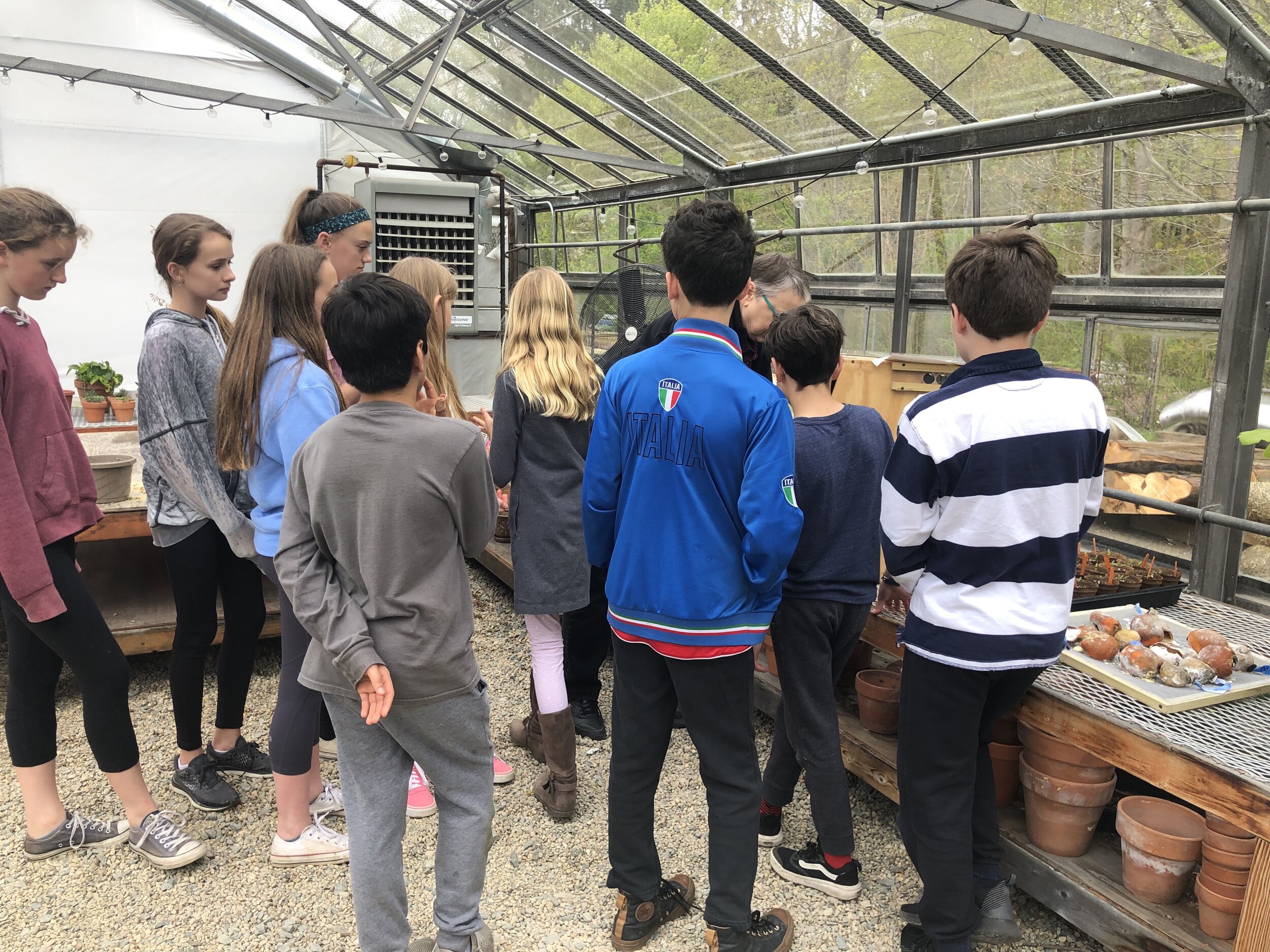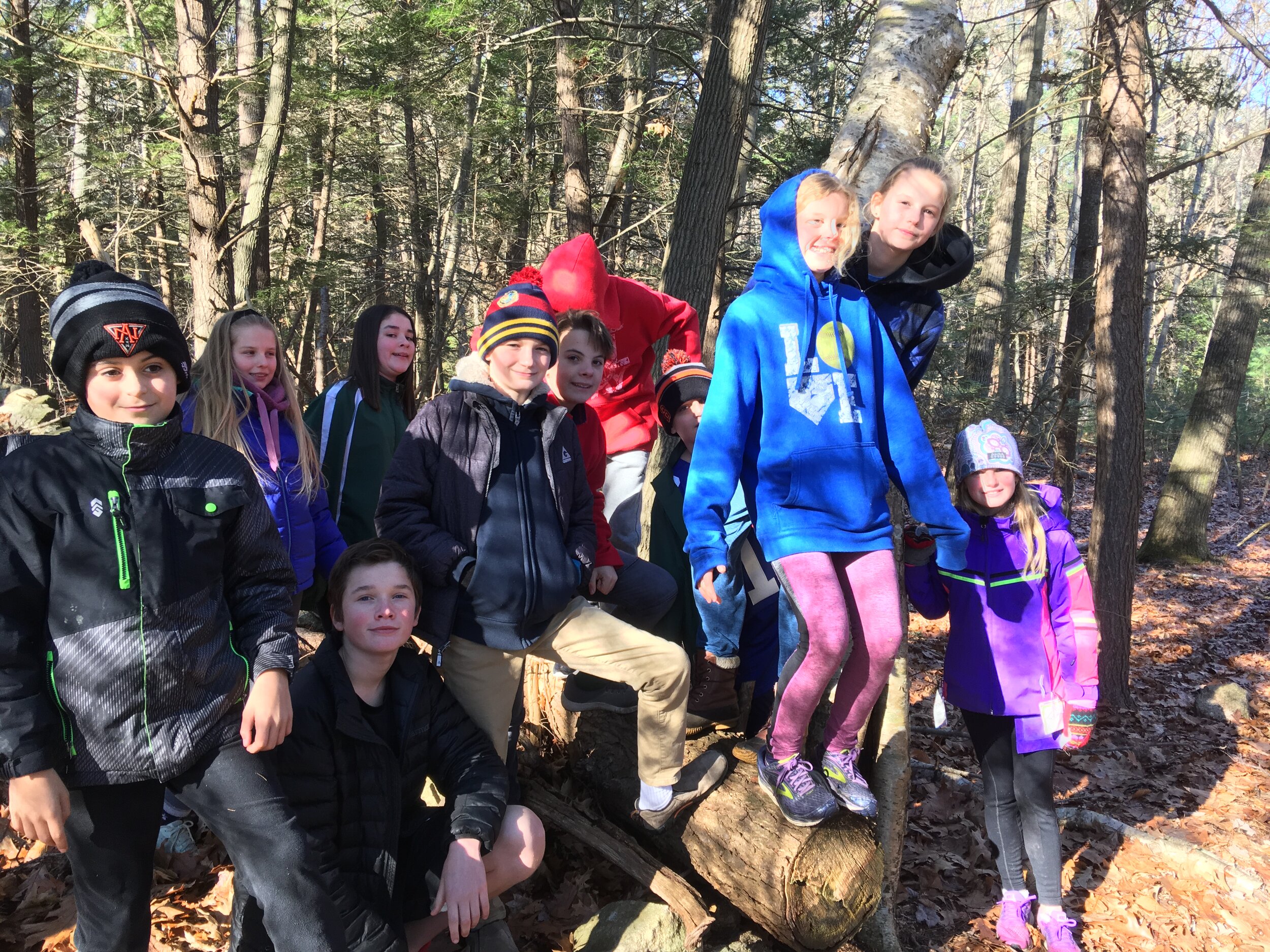The people
An exploration of different groups of people and how they relate to one another across geographical and historical boundaries.
Our Curriculum
+ Social Studies
In social studies, sixth grade students launch into their yearlong theme, “The People,” by studying how humans interact with their environments through work, art, recreation, and thought. They study and compare various ancient civilizations—Mesopotamia, Egypt, China, and Maya—developing a frame of reference to understand and appreciate cultural differences. As one example of our interdisciplinary approach, students expand their understanding of Egyptian burial practices by mummifying fruit in social studies class and then constructing clay canopic jars for their mummies in art class. They augment their studies with a trip to the ancient civilizations exhibits at the Museum of Fine Arts, in Boston, to examine artifacts. Closer to home, we visit Beverly Commons, conservation land adjacent to the school, to view ancient Native American stone structures.
+ English
Sixth graders explore their theme, “The People,” in English by reading novels, such as The Misfits by James Howe and Seedfolks by Paul Fleischman, that present rich studies of the various personalities who form a community. Students read both fiction and nonfiction examples of people from many walks of life, and through their writing and conversation, they make connections to those characters. Sixth graders also select independent reads from a wide variety of genres and apply active reading skills to comprehend these texts. Using graphic organizers to collect their thoughts and Google Docs to draft and revise their work, students respond to literature, create original narratives, and strengthen their writing skills. Sixth graders focus on developing a mature syntax and vocabulary for their written expression, and they gain confidence and hone their public speaking skills through many opportunities to share their work. They use Academic Approach tutorials to expand vocabulary and the IXL web site to practice grammar and mechanics.
+ Science
In science, sixth graders formulate questions about their world by learning to see it as scientists do. We begin by learning about scientific classification, dichotomous flow charts, and diagrams. We explore the universe through the vantage points of various disciplines: astronomy, physics, ecology, and oceanography. Students learn about weather, how weather affects the way people live today and in ancient times, in industrialized and in third world countries, how advances in weather technology have improved lives. They learn about pioneers in air and space science and, working in small groups, they design, build, and program Lego Mars Rovers. They build circuit boards using recycled electronics. In preparation for a three-day trip to Heifer International Farm, they learn about sustainability and how people can learn to make sustainable choices that can help to alleviate food scarcity around the world.
+ Mathematics
The sixth grade math curriculum prepares students to study algebra through the study of integer operations. Students use checkers to model positive and negative integers. Once they understand the procedures, they create word problems that require addition and subtraction of negative and positive integers. Rather than merely apply a known strategy to solve a problem, we ask students to devise their own plan, apply it, and, if it works, explain to others how and why it works. As part of their interdisciplinary study, sixth graders consider the number systems of the Mayans, Egyptians, Babylonians, and Greeks, not only as windows into those ancient cultures but to deepen their understanding of our own decimal place-value number system.
+ Social/Emotional
Rounding out the sixth grade program is a once-a-week life skills class in which students learn skills for healthy decision-making, communication, problem solving, and conflict resolution.
+ Latin
Latin instruction spans sixth through eighth grade. Latin is an important core subject in the upper school that develops logical thinking, reinforces grammar and syntax, deepens vocabulary, and provides a bridge to the history studied in other classes. Using the reading-based curriculum Ecce Romani, students complete the first volume of a two-volume Latin I text. Sixth graders focus on parts of speech, vocabulary memorization, noun-adjective agreement, subject-verb agreement in Latin and English, and simple composition in Latin. The reading aspect of the curriculum is divided between comprehension and translation skills. Projects focus on people who still speak Latin or its derivatives and on the Romans themselves. Sixth graders learn which people speak derivatives by completing a chart that links Latin words French, Italian, Romanian, Spanish, and Portuguese words. In addition, they explore how the words changed from Latin into the modern equivalents, while also tracing the history of the development of English. Class discussions intersect with the grade theme, “The People,” as students consider family, class, and cultural identity in Roman society and compare them to their own.
+ Spanish
Because sixth grade is a common entry point to Glen Urquhart, the upper school Spanish curriculum does not require mastery of the vocabulary and themes introduced in lower school. All sixth graders begin upper school Spanish with the same material. They focus on the skills of listening, reading, writing, and communicating. Classes are primarily conducted in Spanish, and students are asked to converse and write in Spanish using correct grammar and spelling, different verb tenses, and vocabulary pertaining to a particular theme. Students review or are introduced to vocabulary previously taught and then learn the geography of the Spanish speaking world, words for classroom objects, definite and indefinite articles, how to express likes and dislikes with infinitive verbs, the calendar, how to tell time, food and restaurant vocabulary, clothing, agreement in gender and number of adjectives, and the verbs ser and estar. The upper school curriculum continues to encourage students to “respect all people and value their differences.” Sixth graders learn a lot about how others live in Spanish speaking countries, their customs and culture, and they continue to explore the holidays of El Día de los Muertos, La Navidad, Carnaval, Las Fallas, and El Cinco de Mayo.
+ Visual Arts
Art classes are designed so that sixth graders can experience success in a multidisciplinary studio environment. Students are introduced to 2-D concepts and processes. They assemble mixed-media collages, integrating drawing and magazine images of popular culture. They create sculptures from found materials—a project that fosters discussions about recycling and the environment. They explore the techniques of 20th Century artists who approached their materials with free association and enthusiasm.
In a drawing unit, students become very conscious of line and its infinite possibilities in both representational and abstract genres, and they learn that there are many “right ways” to draw. They make still-life drawings of inanimate objects. With “discovery being the goal,” they consider such questions as: How does a line represent the edge of a form? How is volume created with shading? How is perspective shaped with depth on a 2-D plane?
In a project that integrates social studies and art, students create delicate clay Egyptian canopic jars (vessels with stoppers fashioned into animal heads) to hold mummified fruit remains. They also create delicate black and gold ink scratch drawings of Egyptian vessels, goddesses, symbolic animals, and hieroglyphics. When they study Ancient China, students explore Chinese brush and ink painting techniques, including calligraphy and landscape works on paper.
+ Music
In sixth grade music, students learn to sing in solfege—a music education method that teaches children pitch, harmony, and sight singing—and to sign each solfege syllable (do-re-mi-fa-sol-la-ti-do). In the fall, we prepare a repertoire of songs for Grand Friends’ Day, their first official performance. They learn about classical music, jazz, pop, and musical theatre and how each genre has evolved over time. Continuing to work on solfege, students learn to sight read and identify key signatures and time signatures. In preparation for their Winter Solstice performance, the class is broken into voice parts (soprano, alto, etc.) and works on harmonizing as a group. Finally, each student researches a major piece of music and gives a presentation about the composer and the place of the piece in music history. By year’s end, sixth graders can sight read independently and as a group and they have begun to develop a rich musical vocabulary.
+ Dance
For sixth graders, dance is a Limon/Cunningham/Release technique–based modern class. In addition to learning basic modern techniques, students engage in contemporary partnering, inversions, and floorwork, and they choreography outdoor, site-specific student dances. As the culmination of year, the sixth graders perform these dances for the school community, moving around the campus to perform in the historic and aesthetic spaces that inspired their work.
+ Physical Education
In sixth grade physical education, or sports (which physical education becomes in upper school), two teachers work together to teach a specific sport to the whole group each season (except in the case of lacrosse, where students are divided by gender). We assess the abilities of each student and the entire class. Then we develop practice plans and specific drill plans to help students master the rules and fundamentals, improve skills, and prepare for game play on seventh and eighth grade soccer, basketball, and lacrosse teams. We schedule just a couple of games against other schools for sixth graders. As always at GUS, all students participate in all activities. There are no tryouts and no cuts.
+ Community Service
For their community service work, sixth graders volunteer with The Food Project, an organization that delivers more than 60,000 pounds of locally grown produce to community-supported agriculture (CSA) share members, hunger relief organizations, and area farmers’ markets. Specifically, the students help Food Project staff propagate seedlings in the Glen Urquhart’s 7,000-square-foot greenhouse. Students also volunteer for on-site farm workdays and educational workshops that explore issues related to local and global food systems.



